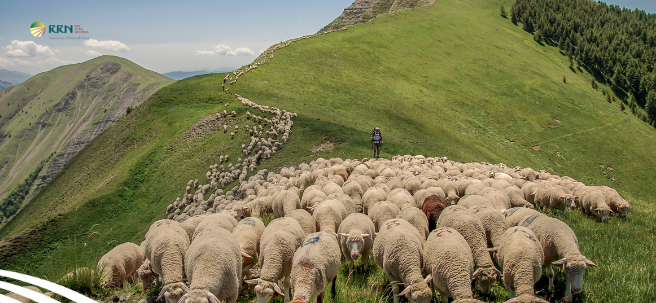
22 de October de 2021
What is transhumance? A type of grazing that reproduces the natural tendency of animals to move in search of available green pastures depending on the season, in valleys or highlands.
- The Ovinnova Operational Group has dedicated 3 years to assisting transhumant livestock farms, as well as to training and organic certification of pastures and livestock farms.
- Its objective has been to improve transhumant grazing, an activity that helps conserve habitats, through the use of innovative technologies.
The OVINNOVA Operational Group was created in 2019, made up of 12 entities, to work on transhumance and with the aim of improving the competitiveness of transhumant grazing , proposing a new business model of viable, productive, competitive livestock services that contribute to preserving biodiversity .
This goal has led the Operational Group – until its dissolution last September 2021 – to cover activities such as:
- administrative and logistical support for transhumant livestock farms.
- for habitat conservation.
- Use of innovative technologies , both in the receiving and transmitting areas of livestock (Cantabrian mountain range and pastures in southern Spain).
Results
Ovinnova has set 5 objectives in its creation:
- New transhumance management framework using innovative technologies - The goal of this initiative is to achieve fluidity in livestock management and movement. To achieve this:
- A management center (north-south) has been created.
- A transhumance management platform has also been created through a web application.
- Field logistics procedures have been established (food, telephone and digital coverage).
- Logistical support for shepherds and flocks (dog training).
- Implementation of an innovative business model – The goal is to facilitate the management of herds from different farms by providing the logistics, facilities, and personnel necessary to graze the livestock. To achieve this, the following were necessary:
- Identify ranchers interested in grazing.
- The establishment of the protocol for livestock movements between regions.
- Logistics and procedures programming for livestock transportation.
- Livestock management in ports according to the coverage schedule for the different herds.
- Cost evaluation and development of economic management itineraries.
- Certification of pastures and transhumance products.
- Habitat Improvement – The goal was to design diagnostic and assessment tools for the biodiversity of Mediterranean mountain and grassland systems that would enable managers to make decisions for their conservation. How was this achieved?
- Conducting a study of quality indicator parameters in selected areas without grazing and with grazing by transhumant livestock.
- Demonstration of the effectiveness of very high spatial resolution multispectral images in detecting ecosystem biodiversity under grazing scenarios.
- Provide indicators of functional soil quality from samples obtained in the field.
- Holistic land management – The ambition is to design a livestock management model that integrates experience with innovation and social issues, in order to provide a broader framework for managing transhumant pastoral systems. Through:
- The use of IoT and satellite technologies to collect data on grazing patterns by using GPS devices integrated into livestock collars to monitor changes in vegetation and weather.
- A virtual recreation of a port and a pastureland that establishes the most appropriate grazing patterns at any given time, created from the data obtained.
- Design of a livestock management model using a biodynamic approach that integrates sustainability and habitat conservation.
- Installation of threat warning systems to establish protocols for shepherd defense.
- Job integration - Training and empowering young shepherds to meet the traditional and future challenges of transhumance:
- Through theory sessions and practical work with shepherds at transhumant ports and through exchanges with the Professional School for Shepherds in Triesdorf, Germany.
- Creation of an “International Meeting of Transhumant Shepherds and Ranchers.”
- Framework for pastoralist-rancher collaboration linked to the operation of the Management Center.
- Development of a training plan: which includes the creation of training materials and the definition of a curriculum for pastor-students.
These results were presented by Ovinnova on September 15, 2020, in a conference that can be viewed here .











